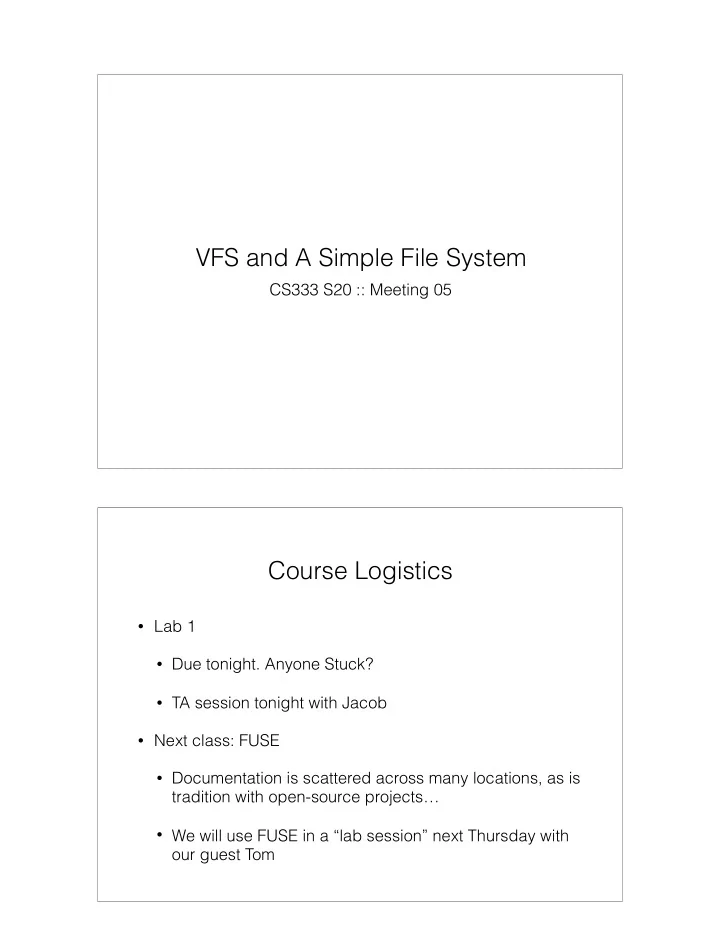

VFS and A Simple File System CS333 S20 :: Meeting 05 Course Logistics • Lab 1 • Due tonight. Anyone Stuck? • TA session tonight with Jacob • Next class: FUSE • Documentation is scattered across many locations, as is tradition with open-source projects… • We will use FUSE in a “lab session” next Thursday with our guest Tom
Course Logistics • Lab 2: Hello FUSE • Build “restricted functionality” file system using FUSE: • Allow reading and writing to 1 file only • Can’t create new files or delete existing files • We will be using “Panic” machines in TCL 312 • Given “root” privileges; use non-CS accounts • (required) partners for lab due to limited machines && because it is likely how you will be working in the “real world” Last Class • HDDs • Geometry • Caching • Scheduling
This Class • VFS and Simple File system • Similar in practice to some real file systems (FFS, ext4) • This is the design we will implement later in Lab Key VFS Data structures • inode • Persistent information about a single file • “Index” node (indirection node?) • superblock • Persistent information about entire file system • Allocation structures (several types) • Free list, bitmap, extent list, etc.
Simple File System : On-Disk Layout • Space partitioned into data and metadata • Superblock is located in the first block • Why? • Static inode table • Static data block allocation bitmap Simple File System : On-Disk Layout Inodes Data Region S i d D D D D D D D D D D D D D D D D D D D D D D D D I I I I I 0 7 8 15 16 23 24 31 Data Region D D D D D D D D D D D D D D D D D D D D D D D D D D D D D D D D 32 39 40 47 48 55 56 63 (OSTEP Chapter 40)
Simple File System On-Disk Layout The Inode Table (Closeup) iblock 0 iblock 1 iblock 2 iblock 3 iblock 4 0 1 2 3 16 17 18 19 32 33 34 35 48 49 50 51 64 65 66 67 4 5 6 7 20 21 22 23 36 37 38 39 52 53 54 55 68 69 70 71 Super i-bmap d-bmap 8 9 10 11 24 25 26 27 40 41 42 43 56 57 58 59 72 73 74 75 12 13 14 15 28 29 30 31 44 45 46 47 60 61 62 63 76 77 78 79 0KB 4KB 8KB 12KB 16KB 20KB 24KB 28KB 32KB (OSTEP Chapter 40) Example inode Fields (ext2) Size Name What is this inode field for? 2 mode can this file be read/written/executed? 2 uid who owns this file? 4 size how many bytes are in this file? 4 time what time was this file last accessed? 4 ctime what time was this file created? 4 mtime what time was this file last modified? 4 dtime what time was this inode deleted? 2 gid which group does this file belong to? 2 links count how many hard links are there to this file? 4 blocks how many blocks have been allocated to this file? 4 flags how should ext2 use this inode? 4 osd1 an OS-dependent field 60 block a set of disk pointers (15 total) 4 generation file version (used by NFS) 4 file acl a new permissions model beyond mode bits 4 dir acl called access control lists Figure 40.1: Simplified Ext2 Inode (OSTEP Chapter 40)
Access Patterns: open(“/foo/bar”), read() data inode root foo bar root foo bar bar bar bitmap bitmap inode inode inode data data data[0] data[1] data[2] read read open(bar) read read read read read() read write read read() read write read read() read write Access Patterns: Creating a File data inode root foo bar root foo bar bar bar bitmap bitmap inode inode inode data data data[0] data[1] data[2] read read read read create read (/foo/bar) write write read write write read read write() write write write read read write() write write write read read write() write write write Figure 40.4: File Creation Timeline (Time Increasing Downward)
VFS Handout (sync up at end) Course Logistics: Up Next • Lab 2 (Hello, FUSE!) • Fill out partner survey (linked on course “labs” page) • Tom will help to answer questions during lab • I’ll be gone next Monday afternoon until Sunday (FAST conference)
Recommend
More recommend